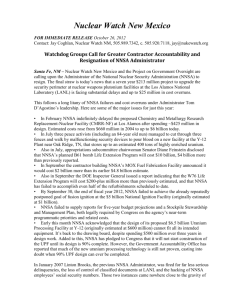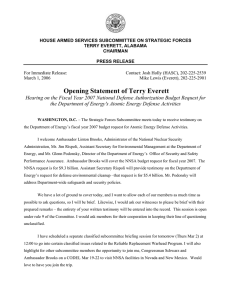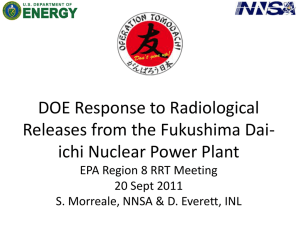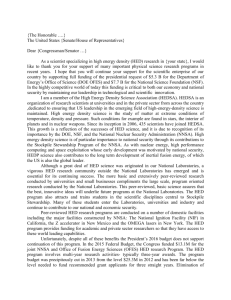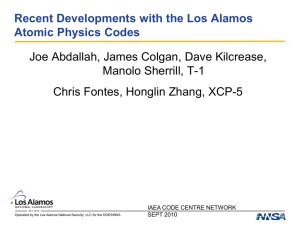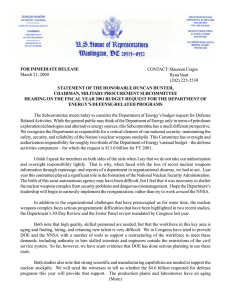GAO Testimony
advertisement
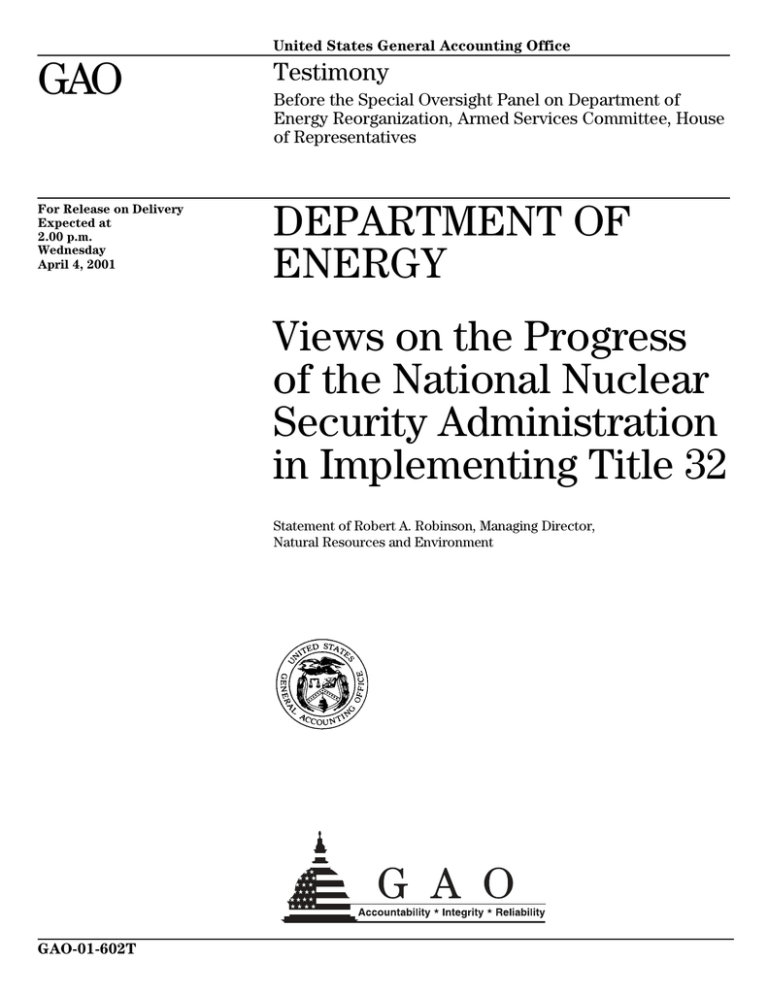
United States General Accounting Office GAO Testimony For Release on Delivery Expected at 2.00 p.m. Wednesday April 4, 2001 DEPARTMENT OF ENERGY Before the Special Oversight Panel on Department of Energy Reorganization, Armed Services Committee, House of Representatives Views on the Progress of the National Nuclear Security Administration in Implementing Title 32 Statement of Robert A. Robinson, Managing Director, Natural Resources and Environment GAO-01-602T Mr. Chairman and Members of the Special Panel: We are pleased to be here today to provide our observations on the progress the National Nuclear Security Administration (NNSA) has made in implementing Title 32 of the National Defense Authorization Act for Fiscal Year 2000 (P.L. No. 106-65). As the Panel is well aware, Title 32 established NNSA as a semiautonomous agency within DOE with responsibility for the nation’s nuclear weapons, nonproliferation, and naval reactors programs. NNSA was created to correct long-standing and widely recognized management problems at DOE, which had been underscored by significant cost overruns on major projects and security problems at the national laboratories. As you will recall, when we testified before the Panel last March, we were concerned that DOE's approach to establishing NNSA had simply transferred many of DOE’s 1 historic shortcomings to the new agency. These shortcomings included DOE officials contemporaneously serving in NNSA and DOE positions (so called "dual-hatting”), unclear lines of authority, a confusing field structure, and “business-as-usual” approaches to planning, programming, and budgeting, and personnel issues. Frankly, it was clear that NNSA had not gotten off to the best possible start. Since that time, at the Panel’s request, we have been monitoring NNSA’s progress in implementing key components of Title 32, including its reorganization efforts; integrated planning, programming and budgeting improvements; and use of NNSA's personnel authority. We are pleased to report that NNSA has begun to move in the right direction. The agency is making progress in implementing changes to its organization; planning, programming, and budgeting functions; and use of personnel authority. However, it may be several months before we see real, tangible evidence of these changes. And it may be several years before these changes are fully implemented and can be definitively assessed. In this connection, much important work remains to be done in Establishing an organization that clearly defines the roles and responsibilities of headquarters and field staff; moves program management officials as close to the action as possible, and establishes clear lines of authority between NNSA and its contractors; Implementing an integrated planning, programming, and budgeting system that can deliver information to decision makers and the Congress in time for the 2003 budget deliberations; and Overcoming obstacles to using NNSA’s Excepted Service authority so that it can attract and retain the technical personnel needed to effectively oversee its diverse operations. NNSA’s performance in addressing these three sets of challenges will go a long way toward determining whether it will be successful in correcting DOE’s long-standing management problems. After a brief overview of the factors that led to the creation of 1 See Department of Energy: Views on DOE’s Plan to Establish the National Nuclear Security Administration (GAO/T-RCED-00-113, Mar. 2, 2000). 1 NNSA, we will discuss each major management area in more detail, including the underlying problems to be addressed, the changes NNSA has made, and the challenges ahead. Background Since its creation in 1977, DOE has conducted technically complex activities at its facilities across the country. These activities include developing, producing, and maintaining nuclear weapons; preventing the proliferation of weapons of mass destruction, and designing, building and maintaining naval nuclear propulsion systems. However, in conducting these activities, DOE has historically been plagued by organizational and managerial problems that have resulted in significant cost overruns and schedule delays on major projects, as well as the failure to complete and operate some of those projects. These problems continue, as the recent cost overrun of over $1 billion and schedule delays with the National Ignition Facility demonstrate. There have also been a number of security concerns at DOE facilities. Ultimately, the Congress concluded that DOE, as configured at the time, could not be counted on to correct these organizational and managerial problems. Accordingly, in Title 32 of the National Defense Authorization Act for Fiscal Year 2000, the Congress created a new semiautonomous agency within DOE—the National Nuclear Security Administration. As required by the act, DOE issued an Implementation Plan for the creation of NNSA in January 2000. The Implementation Plan called for three program offices within NNSA, support offices, and a field office organization. In the Panel’s view, DOE’s plan, as originally crafted, was not in keeping with the intent of Title 32. As a result, the fiscal year 2001 National Defense Authorization Act (P.L. No. 106-398) amended Title 32 to require, among other things, additional information on NNSA’s organization, planning, programming, and budgeting. NNSA’s first Administrator, General John A. Gordon, was sworn in on June 28, 2000. Since the Administrator’s appointment, NNSA has undertaken a number of actions to comply with Title 32, including announcing a proposed headquarters restructuring effort, with a field restructuring proposal to be announced in May 2001; undertaking the development of a formal Planning, Programming, and Budgeting System (PPBS), including developing a Future Years Nuclear Security Program plan; and drafting a proposal to use NNSA’s Excepted Service personnel authority. NNSA’s Reorganization Holds Promise, but Important Challenges Remain NNSA was established, in part, to correct the confused lines of authority and responsibility within DOE’s nuclear weapons complex that contributed to a wide variety of problems, such as cost overruns and schedule slippage on large projects, as well as security lapses. Past advisory groups, internal DOE studies and GAO have reported over the years on DOE’s dysfunctional organizational structure. In particular, in December 2000, we concluded a comprehensive study of the management of the Office of Defense Programs, which makes up over 70 percent of the NNSA. We found that the Office of 2 Defense Programs did not have a clear organizational structure or, until recently, formal control over all of the sites performing its work. In addition, we found that the Office was fragmented at the headquarters level and, more importantly, that the division of roles and responsibilities between headquarters and the field was unclear. This situation made it difficult for the program to be managed as an integrated whole and for managers to make decisions about balancing competing resource priorities. As I noted earlier, to bring a fresher, more independent approach to these kinds of issues, the Congress established NNSA as a semiautonomous agency within, although distinct from, DOE. While it did not specify exactly how NNSA was to be organized, the act did establish certain positions, including the Administrator; Deputy Administrators for Defense Programs, Nuclear Nonproliferation, and Naval Reactors; and a General Counsel. It also established certain offices, including counterintelligence and nuclear security. The act laid out chains of command in both DOE and NNSA that would insulate NNSA from DOE decision making, except at the level of the NNSA Administrator. This is because the Administrator is under the immediate authority of the Secretary. Initially, however, the previous Secretary of Energy chose to fill numerous key NNSA positions with DOE officials—thus, these officials had both DOE and NNSA responsibilities and were dubbed "dual-hatted." This practice caused considerable concern on this Panel and with others, including GAO, that NNSA might not be able to function with the independence envisioned in the NNSA Act. Following this rocky start, I am pleased to report that progress is being made in the area of establishing a better-organized NNSA. The practice of dual-hatting has been eliminated, providing NNSA with the opportunity to exercise a more independent role in managing its programs. Just as importantly, NNSA has recently proposed reorganizing its headquarters operations. In announcing the reorganization, NNSA set as its goals establishing clear and direct lines of communications for laboratory directors and plant managers, clarifying the roles and responsibilities of NNSA headquarters and field offices, and integrating and balancing priorities across NNSA’s missions and infrastructure. To achieve these goals, the Administrator is proposing to establish an Associate Administrator for Management and Administration and an Associate Administrator for Facilities and Operations. He is also proposing to establish, through legislative change, the position of Principal Deputy Administrator to assist him. The Principal Deputy Administrator; Associate Administrators; and the Deputy Administrators for Defense Programs, Nonproliferation, and Naval Reactors would serve on a management council with the Administrator and his staff to make integrated decisions for the entire NNSA. The reorganization also established the other offices required by Title 32, such as the Office of Defense Nuclear Counterintelligence. Currently, only a broad outline of the major functions of these new offices have been defined. This structure holds significant promise for addressing the long-standing deficiencies we and others have identified, in particular because it can reduce the fragmentation at the headquarters level and can allow for integrated decision making across NNSA’s disparate parts. However, the new structure does not yet realize all of NNSA’s goals because it leaves several major organizational deficiencies unaddressed. Specifically, the 3 reorganization does not address clearly define the roles and responsibilities of each of the headquarters offices. It also does not address the critical issue of the relationship between NNSA headquarters and its field offices and whether headquarters or field officials will direct and oversee NNSA’s contractors. Finally, it does not directly address the relationships between NNSA and DOE, in such areas as whether final decisions on NNSA personnel appointments will be made by the Administrator or the Secretary. NNSA officials recognize these weaknesses. They have promised to resolve these issues in an implementation plan they will submit to the Congress by May 1, 2001, and to complete the reorganization by October 1, 2001. However, NNSA officials have told us that they are concerned about their ability to address all of the difficult issues that will need resolution before these deadlines—a concern we share. Creating a new organization will constitute a major cultural change for all of the components of NNSA—a change that has occurred very infrequently. For example, the headquarters/field relationships for much of the Office of Defense Programs were last officially defined in 1968. Numerous attempts to update these relationships have been unsuccessful. Moreover, the Office of Naval Reactors is a unique joint Department of Defense (DOD)-DOE operation that has enjoyed an independence of operation within DOE since its creation by Admiral Rickover. In order to effectively reorganize and achieve the goals the Administrator has set for the organization, NNSA will have to (1) clearly understand the existing roles of its disparate program offices, (2) identify opportunities to reduce duplication and achieve efficiencies both in headquarters and in the field, and (3) ensure that the right people are in the right places by hiring or moving them to their new organizational unit. This process will take time to "get it right." As NNSA moves forward, we believe that it needs to employ the organizational principles endorsed in the Institute for Defense Analyses’ 120-Day Study, the Chiles Commission report, and our review of the management of the Office of Defense Programs.2 These principles include establishing a small headquarters staff focused on top-level management tasks, such as strategic management and working with external customers; moving program management officials as close to the action as possible; establishing clear lines of authority between NNSA and its contractors; and holding federal and contractor employees accountable for meeting mission goals. NNSA Is Taking Steps to Improve Its Planning, Programming, and Budgeting, but Much Remains to Be Done Numerous studies, including the 120-Day Study, the Chiles Commission, our report on the management of the Stockpile Stewardship Program, and the Foster Panel have 2 See The Organization and Management of the Nuclear Weapons Program, Institute for Defense Analyses (known as the 120-Day study) (Mar. 1997) and Report of the Commission on Maintaining United States Nuclear Weapons Expertise to the Congress and the Secretary of Energy, Commission on Maintaining United States Nuclear Weapons Expertise (known as the Chiles Commission) (Nov. 1999). 4 identified problems in DOE's planning, programming, and budgeting.3 These problems have included the lack of a unified planning and programming process, the absence of integrated long-range program plans, and plans that were not fully linked to budgets and management controls. Without sound planning, programming, and budgeting, it has been difficult for officials to ensure that decisions with resource implications are weighed against one other in a complete and consistent fashion. Title 32 mandates the use of sound planning, programming, budgeting, and financial activities. However, in its original implementation plan for NNSA, DOE said that existing DOE planning, programming, and budgeting processes would fulfill Title 32 requirements. Needless to say, given the history of management problems at DOE, we, as well as others, did not believe this response was adequate. To his credit, neither did the Administrator. He made a commitment to prepare a multiyear budget and program plan, as required by Title 32, by establishing a programming, planning, and budgeting system—generally referred to as PPBS—similar to the system used by DOD for 40 years. While the use of PPBS has not been without problems in DOD, it is generally recognized as a system that, when properly led and staffed, is capable of making cost-effectiveness comparisons and of developing the detailed program and budget plans called for in Title 32. In DOD, PPBS has served generally to increase the visibility of the budget process, provide a “roadmap” for future priorities, and facilitate congressional oversight. The Administrator set a goal of having NNSA's PPBS fully established by the fiscal year 2003 budget cycle. While NNSA has made progress over the past several months, key components of a fully operational PPBS have yet to be finalized or, in some cases, even initiated. Specifically, program elements—the building blocks of PPBS—are still in the “brainstorming” phase. The necessary guidance and documentation needed to describe and explain the PPBS to the NNSA staff have not been finalized. Decision and information systems, which are key components of a modern PPBS, will not even be discussed until the summer. Moreover, these systems will have to interface with existing DOE financial and budget systems. Few PPBS-trained personnel are available to staff the central NNSA PPBS office, although NNSA estimated that it might need as many as 15 analysts. While NNSA advertised for a senior person to head its PPBS office earlier in the year, it did not attract any qualified candidates and NNSA will probably have to re-advertise the position. Finally, NNSA will have to take action to make sure that its PPBS helps satisfy the requirements for performance measures called for in Title 32 and in the Government Performance and Results Act. PPBS offers the potential to help bring NNSA into compliance with some aspects of Title 32. Nevertheless, the fiscal year 2003 budget cycle is just around the corner and, given the enormous amount of work that will need to be completed before NNSA has even a minimally functional PPBS, it seems likely that NNSA's fiscal year 2003 budget, as well as the fiscal year 2003-08 Future Years Nuclear Security Program plan, will not be able to make full use of PPBS. Some NNSA officials have conceded that, without the use of 3 FY 1999 Report of the Panel to Assess the Reliability, Safety, and Security of the United States Nuclear Stockpile, Foster Panel (Nov. 1999). 5 PPBS tools, the value of the current Future Years Nuclear Security Program plan, now with the Office of Management and Budget for review, may be limited. NNSA Is Developing Plans to Use the Personnel Authority Granted Under Title 32 Retaining and recruiting the highly skilled scientific and technical personnel needed to make our government run efficiently and effectively challenges virtually every federal department and agency. DOE, and in particular the Office of Defense Programs, has had difficulty meeting this challenge because of downsizing and program instability over the past decade. We and others have concluded that the lack of technically competent DOE personnel has contributed to weak contract management and to poorly managed projects that are often late or over budget. In response to this situation, Title 32 provided NNSA with hiring and salary flexibility under Excepted Service rules for 300 positions for scientific, engineering, and technical staff. To date, NNSA has not used this personnel authority. While NNSA has hired only a small number of staff (less than 20), it has done so under pre-existing DOE authorities for General Schedule, Excepted Service, and Senior Executive Service personnel. NNSA also continues to utilize personnel services provided by DOE’s Human Resources office, and senior NNSA hires must be approved by DOE’s Executive Resources Board, which is chaired by the Secretary of Energy. While this arrangement has been satisfactory at present, NNSA officials are concerned that the DOE system will probably not be capable, flexible, or timely enough to handle NNSA's hiring needs in the future. NNSA has drafted a proposal that will allow it to use the personnel authority established under Title 32. This proposal includes features such as pay-for-performance criteria and pay banding for the 300 positions specified by the law. In contrast, the rest of NNSA’s approximately 1700 federal employees would remain in the standard federal General Schedule system, except for those in the Senior Executive Service. It also requests that the Secretary of Energy delegate the authority to NNSA for its own Executive Resources Board, which would allow the NNSA Administrator to select his own senior-level staff. In addition, NNSA’s proposed headquarters reorganization includes a human resource office as part of the Management and Administration organization. NNSA faces a number of challenges in implementing its personnel proposal. For example, DOE's analysis shows that as many as 800 NNSA positions may qualify for the type of scientific, technical, or engineering personnel specified in the law, but Title 32 provides for only 300 positions. As a result, if only some NNSA positions are converted to Excepted Service, with its pay-banding, pay-for-performance, and bonus provisions, NNSA federal employees doing the same work could receive significantly different levels of compensation. This could be especially troublesome for the Office of Naval Reactors, which is currently staffed from three sources—NNSA civilian employees, Navy civilian employees, and Navy military employees. NNSA officials are cognizant of these problems, and believe that eventually NNSA may need to move to the model used by organizations like the Nuclear Regulatory Commission, which is almost all Excepted Service, to fully address these issues. Also, according to NNSA officials, the use of 6 Excepted Service flexibilities may be opposed by labor unions. While less than 10 percent of NNSA’s workforce is unionized, NNSA officials and Office of Personnel Management officials have told us that they believe organized labor generally opposes Excepted Service. NNSA officials noted that the unions have already requested massive amounts of data on NNSA’s reorganization and that union opposition has delayed the reorganization of DOE’s Office of Environmental Management for over 18 months. ----Our work was performed during March and April 2001 in accordance with generally accepted government auditing standards. Mr. Chairman, this concludes my testimony. I would be happy to respond to any questions you or Members of the Special Panel may have. (360070) 7

